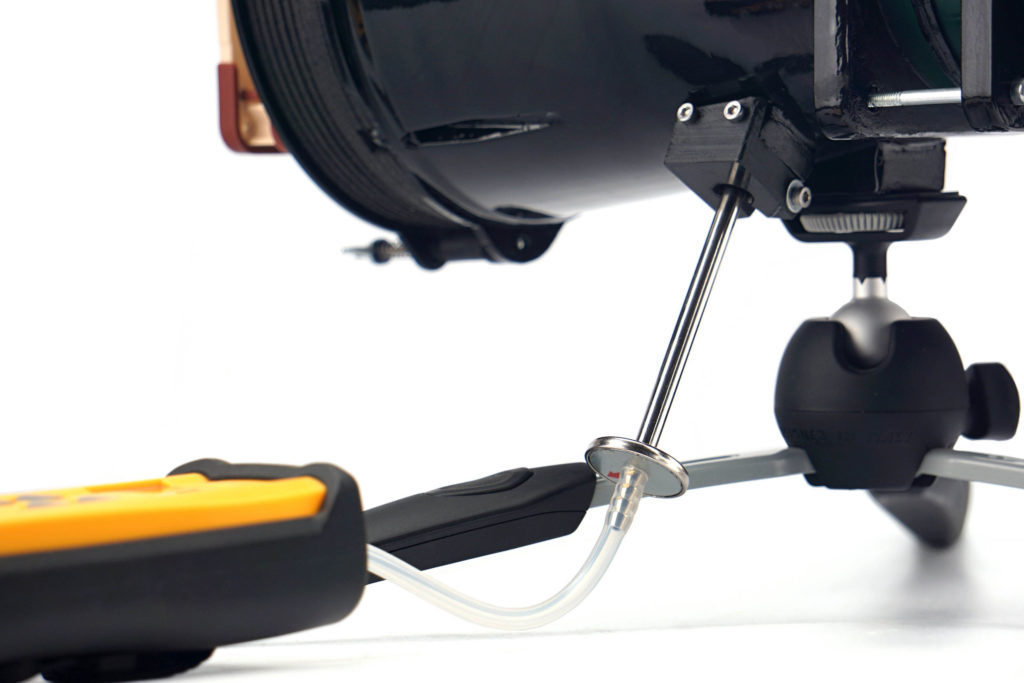Static pressure measurement…
It is made in the same injection mould as the FC120, but still has noticeably better properties. Stronger material, higher weight, different bearings and a more powerful motor make the FK120 one of the most attractive options among inexpensive fans. But that’s only assuming the “right” adjustment. Outside of that, this fan can be quite uncomfortable and ironically for the same reason it is sometimes unbeatable.
Static pressure measurement…
Finally, it is time to move further down the tunnel a bit. Just behind the fan is a static pressure sensing probe. Its position has been chosen with maximum measurement efficiency in mind. In other words, the sensors are placed at the points of highest pressure (although this is virtually the same everywhere in the unconstrained part of the tunnel).
The Fieldpiece ASP2, which is connected to the Fieldpiece SDMN5 manometer, is used to measure the static pressure in the tunnel. The latter also allows measurements in millimetres of water column, but we measure in millibars. This is a more finely resolved base unit for this meter. And only from there we convert the measured values into mm H2O to allow easy comparison with what the manufacturers state.

While we wrote when measuring noise levels that our results could not be compared with the parameters, that is no longer the case here. As long as the fan manufacturers do not embellish the parameters, they should quote approximately the same pressure values as our tests show. The most significant deviations can only arise at the level of varying accuracy of the measuring instruments, but these are negligible percentages.

The greater the difference between the manufacturer’s claimed values and ours, the less the specifications correspond to reality. If the claimed values are significantly higher, it is certainly an intention to artificially give an advantage to the fans on the market. However, if the manufacturer quotes a lower pressure value than we do, it points to something else. Namely, a weaker tightness of the measuring environment. The less tight the tunnel is, the lower the pressure you naturally measure. This is one of the things we tuned for an extremely long time, but in the end we ironed out all the weak spots. Whether it’s the passage for the probe itself, the flanges around the anemometer, even the anemometer frame itself, which is made up of two parts, needed to be sealed in the middle. Finally, the flap at the tunnel outlet must also be perfectly tight. That’s because static pressure has to be measured in zero airflow.

But there is one thing that often lowers the pressure of the fans a bit. And that’s protruding anti-vibration pads in the corners or otherwise protruding corners. In other words, when the fan doesn’t fit perfectly to the mounting frame at the inlet, and there are small gaps around the perimeter, that also affects what you measure. But we have not gone into this because it is already a quality feature of the fan. In the same way, it will “stand out” and perform a bit weaker than it has the potential to do with better workmanship, even after application by the end user.
- Contents
- DeepCool FK120 in detail
- Basis of the methodology, the wind tunnel
- Mounting and vibration measurement
- Initial warm-up and speed recording
- Base 6 equal noise levels…
- ... and sound color (frequency characteristic)
- Static pressure measurement…
- … and airflow
- Everything changes with obstacles
- How we measure power draw and motor power
- Measuring the intensity (and power draw) of lighting
- Results: Speed
- Results: Airlow w/o obstacles
- Results: Airflow through a nylon filter
- Results: Airflow through a plastic filter
- Results: Airflow through a hexagonal grille
- Results: Airflow through a thinner radiator
- Results: Airflow through a thicker radiator
- Results: Static pressure w/o obstacles
- Results: Static pressure through a nylon filter
- Results: Static pressure through a plastic filter
- Results: Static pressure through a hexagonal grille
- Results: Static pressure through a thinner radiator
- Results: Static pressure through a thicker radiator
- Results: Static pressure, efficiency by orientation
- Reality vs. specifications
- Results: Frequency response of sound w/o obstacles
- Results: Frequency response of sound with a dust filter
- Results: Frequency response of sound with a hexagonal grille
- Results: Frequency response of sound with a radiator
- Results: Vibration, in total (3D vector length)
- Results: Vibration, X-axis
- Results: Vibration, Y-axis
- Results: Vibration, Z-axis
- Results: Power draw (and motor power)
- Results: Cooling performance per watt, airflow
- Results: Cooling performance per watt, static pressure
- Airflow per euro
- Static pressure per euro
- Results: Lighting – LED luminance and power draw
- Results: LED to motor power draw ratio
- Evaluation









Thank you so much for your hard work bringing us these reviews!
Greetings from Brazil!
Hello
Your expert explanation helped me make my final choice between the two DeepCool FK120 fans and the ASUS ROG Strix fan XF120.
The price difference of these two fans in Iran is insignificant and is around 5 dollars.
Overall, according to your tests, I would choose the Deep Cool fan.
I hope it is the right choice.
Your friend from Iran
Choosing the most suitable fan for a specific scenario is highly complex. In addition to the fact that all situations in practice are more or less different, each has a different set of priorities of individual characteristics. Someone may prefer lower vibrations to a slightly higher airflow, so that the fan does not end up being a source of excessive secondary noise in interaction with, for example, the case.
But when you have looked through our tests, taken a look at the context, evaluated the pros and cons, you must have made the right decision. 🙂
it would be more complex if we had more high quality fans on the market, but nowadays it’s mostly limited to whether you want maximum performance without noise or maximum performance disregarding the noise
in the first case you get A12x25 (or T30 if you have space for that), in the other probably some monster from Delta
if we had high quality fans optimized for specific usecases (like Noctua had in older generations, before releasing the overwhelmingly good A12x25) we could extend that choice to low vs high impedance, but nowadays S12A is entirely irrelevant and their static pressure fans are only used to save money